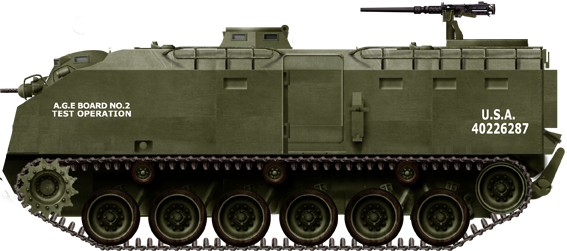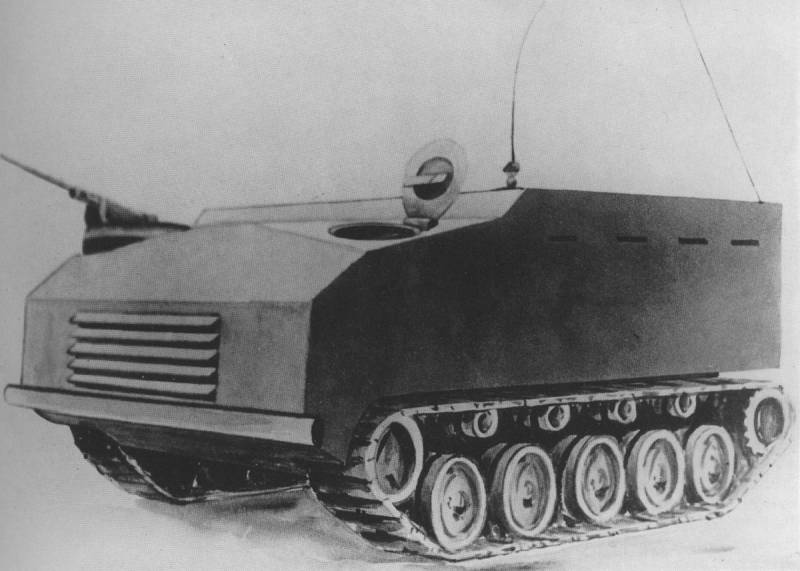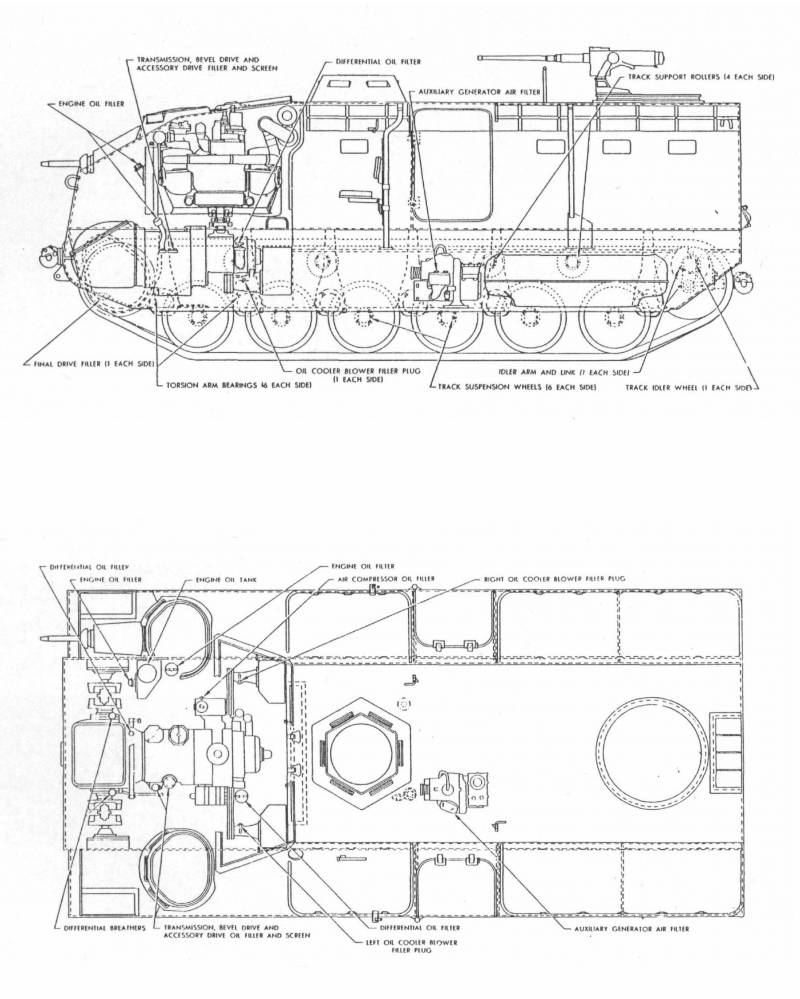The first American Armoured Personal Carrier

In 1945, the US Army already had the experience of armoured personal carrier, thanks to the uniquitous and modular M2/M3 White Halfrack family of vehicles. However its mixed nature (it was not fully tracked) and only light flat armour offered little protection. The Canadians in Normandy started to experiment ad hoc APCs using hull from knocked-out Sherman tanks and other models, leading to an improvized model called the Kangaroo. This had the advantage of offering a level of protection far greater than the M3 Halftrack, despite obvious limited capacity and usability. Once ammunitions and all necessary equipments were removed, they however proved the concept of a better protected APC, fully covered by a hard top for shrapnells.

Artist view of the t-13 (topwar.ru), from Hunnicutt, RP on the Bradley development.
US Army staff questioned the use of a fully tracked, fully enclosed, dedicated APC in 1944 already, but other priorities prevented further progresses. There was already a fully tracked APC in service at that point, the M39 Armoured Utility Vehicle, a development of the M18 Hellcat. Although production stopped in October 1944, its chassis allied high speed and low profile, and by June 1944 already it was decided to develop a recce/prime mover developed under the name T41 Armoured Utility Vehicle. By March 1945, 650 had been built since October 1944, and although room was limited, they could carry six as troop carriers under the name of T41 E1. It was also used in Korea. The M44 Armoured Personnel Carrier was the designation given to a modified version of the latter, by November 1944. Before that, the US Ordnance started work on the T13, a decicated armoured personnel carrier based on the M24 Light Tank to carry 18 to 22 men, to be developed alongside the T33 cargo carrier. However it was soon evident that the M24 engine wouldn't be powerful enough, leadng to the T13 program cancellation by 22 March 1945. It was suggested to use the M18 Hellcat as a base instead, notably its M39 derivative, and work on the T16 armoured utility vehicle started on 5 April 1945.
Design of the M44

General scheme of the vehicle, src: Hunnicutt, RP about the Bradley development.
The M44 Armoured Personnel Carrier had its interior layout altered, with crew of three (driver, bow gunner, commander, plus 24 soldiers seated in the back, on four benches running lengthways down the vehicle: One was on each side, facing inwards and the last two were in the center, back-to-back. As the compartment was enclosed, two large doors were installed at the back of the vehicle, and escape doors on the sides in the middle, plus hatches. The new boxy superstructure offered a completely covered vehicle, looking as the grandfather of all American tracked APCs that would follow. Crucially, the M39 chassis was lenghtened by one axle, from five to six roadwheels per side, with four return rollers per side. The engine, transmission, were the same as the M39 AUV, but placed into the nose, with the commander and driver taking place in individual posts on either side. They each had their own cupola with six sights and a hatched hinged backwards. There was another trap at the rear, where the gunner took place, to man a M2HB .5 caliber Browning heavy machine gun. There was no bow gun, nor pistol ports but sliding shutters on the sides of the troop compartment. The hull had flat sides, and a sloped roof, broken nose in two parts. Behind the engine, in the axis was installed a single observation cupola with better visbility. The front axial position of the engine made for an easier access, but forced the vehicle's width up, making an overall bulky vehicle.
On 12 April 1945 the T16 was accepted for trials and a pre-serie authorized. A limited production order was awarded to Cadillac, which delivered the first six vehicles were to be delivered in June 1945. They were given the designation M44 Armoured Utility Vehicle. It was evaluated for the peacetime army but after a while the army changed its mind and preferred to carry a platoon instead, a single squad of 10-12 men. The M44 was now twice the required size and no longer desired. However its evaluation career did not stopped there. On 31 October 1946, the army allowed Cadillac to modify one of these M44s to take into account the recent trial's reports. This became the M44E1, using a beefer engine and 21-in tracks, while the hull was 10 inches taller and some roof sections could be opened. Side escape doors were removed as a result. Despite all of these changed, the army tested the vehicle but later rejected its entry into production. Cadillac certainly was not to take this as an answer and worked on the M44E2, similar but with raised hull from 10 inches. The M44E2 was further developed into the T17 Command Post Vehicle produced and used by the USAF.

M44 on the LIFE magazine 1951 front cover, showing the new APC max capacity
The massive M44 wasn't adopted, and the M75 instead was chosen, a smaller and more practical vehicle, but with only 10 men capacity. It was later replaced by the M59, cheaper but with similar capabilities. The M59 had an unreliable engine, however and eventually FMC won the race with its iconic M113.
After the approval of the military department the first batch of six vehicles tested in June 1945 and the construction of new prototypes was not excluded if full-fledged mass production was required. The final technical requirements of the original T13 project stipulated to carry 18-22 soldiers fully equipped. Bu the manager of the T16 project found a way to increase this figure to 24, with the help of a new arrangement of the compartment and optimization of internal spaces. It is noteworthy that similar ideas subsequently found application in the creation of following APCs. The T16 BTR became in effect the first such vehicle designed in the United States. The armored personnel carrier received a body made welded armored steel with a front projection nose made of 9.5 to 16 mm thick sloped plates. The sides were 12.7 mm thick (0.5 in), so only capable of protecting against similar heavy rounds. The hull sloping upper front glacis mated to the roof, which shaped comprised three faces. It was indeed connected to the sides by sloped plates, increasing the internal volume, which niches that run the length of the hull. This body layout was determined in accordance with its intended role on the battlefield and maximum safety of the crew. The front section contained a large engine compartment, next to the transmission and gearbox, and the driver compartment. The troop compartment took most of the vehicle's internal space. At chassis level were placed fuel tanks, batteries, generator, and parts.
The T16 was supposed to use M18 self-propelled generator sets, fitted in a new case so the existing systems had to be significantly modified. This was mostly due to space optimisation, with the placement of all components in a single compartment. This powerplant was the R-975-D4 hp 400 type radial gasoline engine, connected to the 900AD Torqmatic transmission, which three forward gears and one reverse. The transmission provided output torque to the drive wheels, so this was, unlike most tanks, a front configuration. This also eliminated the need for a bulky propeller shaft passing under the main compartment. The chassis was based on existing vehicles and parts, with six twin track rollers with independent torsion bar suspension. The four ouwards of these on either side received additional shock absorbers. The drive wheels were at the front, also standard from the M18, as was the idler at the rear, and its tracks tensioning, guide wheels and four return rollers on either side.
The front had a peculiar arrangement never repeated afterwards: The engine was located in the center of the housing, with the pilot and gunner placed on both sides of it. This made quite a large vehicle, with a left-seated driver and his cupola and the gunner to the right, with a ball mount post for a standard .3 Browning M1919A4 machine gun protruding at the break between the front and glacis plate between the lights cage guard structures. Driver and gunner had to climb onto the roof or via the front, to access their hatches. In betwee were located three large exhaust grilles, one rectangular on the glacis plate, two lozenge-shape ones on the joint roof-glacis plate. The commander was was located in his own basket in front of the troop compartment, with an hexagonal cupola with optical devices and a large roof hatch folding backwards. Both the gunner and driver's hatches opens sideways, hinged inwards. The aft part of the roof also contained a railing for a heavy machine gun M2HB which could be activated by one in the infantry. There were also two stowage galleries on either side of the roof's slopes, small ones at the front, larger ones at the rear.
Most of the internal volume belongs to the troop compartment, with seats at first proposed in long benches fitted on the bottom plate and walls niches niches. The compartment was large enough to fit in total two rows of six men back to back for a total of 24. Project T16 had exit facilities in the aft part, and in addition two side, doors and collapsible steps under the back doors. The presence of these side hatches did not affect comfort for the crew or internal arrangements. The aft heavy machine gun armament was installed for self-defense, AA defense and support the infantry during the attack. It was completed by the better protected ball-mounted forward hull starboard M1919A4 provided with 1000 cartridges and controlled manually as in any tank of the era. The M2HB 12.7HB Browning model aft was mounted on the T107 type turret. If necessary, its hatch flap tilted to the right to allow the rise and control of the machine gun. The T-16 was tested by Paratroops, but also the Marines. They tried to fire their personal weapons through windows (and not pistol ports) along the sides of the troop compartment. The first and following three had a sliding cover, located in front and after the side hatches, and two others were as designed placed at the back doors, but these were never installed.
The new T16 had a larger troop compartment, resulting in a marked increase in size and weight, at 6.51 m long for the hull, and 2.44 m in width plus 2.54 m in height, and with the commander's cupola, up to 3.03 m, with a combat weight of 23 t (vs. 17.7 t on the T-13) as in the initial technical requirement. The 400 hp engine was supposed to give it a power-to-weight ratio of 17.4 HP, giving it excellent mobility. Top speed was 51 km/h on road, over a range of 290 km. The T-16 could climb a 30° slope, 61 cm high wall, or cross a 2.1 m gap, but its turning radius was 13 m.
Field tests and standardization as the M44
In April, the US Army ordered in 1945 to build an experimental batch of six armored vehicles with supply of equipment until June inclusive. Cadillac could easily cope with this task and presented all the required armored personnel carriers on time. Soon the vehicles started field tests and confirmed calculated characteristics. Even in its very first version, the T16 could actually transport an entire platoon across any terrain, and protect frpm small arms fire, and support it with machine gun fire. The ball mount LMG and rail-mount HMG could take on two targets simultaneously and destroyer pillboxes and softskin vehicles as well, offer some advantages in combat.Testing went on until the end of World War II. After Japan's surrender, tests continued while the BX T16 received the new designation of the M44 utility armored vehicle, standardized for the US Ordnance. Interestingly, the promising armored personnel carrier was referred to as a "general armored vehicle" or "auxiliary armored vehicle" in these documents. The testing of these six prototypes on Aberdeen and Fort Knox grounds. In the course of this, capabilities of this new equipment were assessed in all conditions while methods for combat use under these same conditions were determined with more precision. Taking into account this experience, the military considered the use of a new equipment on the battlefield, better tailored.
The experience with the T16/M44 armored personnel carrier was double-edge: On one side it performed well, but it also showed it was considered impossible to adopt it. Reasons were that one its main advantages paradoxically became also its own fatal flaw: By the the fall of 1945, the US command updated requirements for APCs. An armored personnel carrier seen through their eyes, capable of transporting the entire platoon did not meet anymore the new requirements based on operative infantry tactics that had been developed as the war progressed. Now the army wanted to operate vehicles carrying a single section. Therefore, the M44 was never accepted for service and stayed as limited standart status, used only for more field tests and training. None was transferred to combatant units, and their carrer ended in the fall of 1946, when it was proposed to carry out a modernization taking into account the accumulated experience. By October 31, 1946, order was given to finalize an existing project, in order to correct identified deficiencies, and improve some features. The new "multipurpose armored vehicle" was called M44E1. It aimed to improve existing technology for research and testing.
The M44E1 engine compartment was modified to fit a more powerful Continental AOS-895-1 engine, capable of 500 hp. The transmission was now the CD-500 and the chassis received a new, larger track with rubber padding. A new hatch for the commander was installed and side doors were abandoned. The M2HB on the roof was removed. The Army felt such changes would made its use easier, the vehicle cheaper for mass-production, and at least one basic prototype was retrofitted to the M44E1 standard and tested. Certain characteristics improved, such as the mobility, but the rest hardly differed as well as the main features including the vehicle being still too large for US requirements.
Final Tests and fate
The M44 and M44E1 had good characteristics, were throughly tested for two years, and this had quite an impact on the army thinking about APCs. Its most useful purpose was to show the US military what size of APC was more desirable, so the M44 sawn its own demise. The idea of carrying an entire platoon, formulated in 1944, was no longer revelant at the start of the cold war, and it has never changed since, but with amphbious models such as the gargantuan LVTP-5. In that case too, the USMC preferred the smaller LVTP-7. The T16/M44 became the only very large fully tracked APC the Army ever had, never adopted, but helping define the bases of future APCs, namely the M75 APC which was based on the M44. The six M44 were decommissioned in 1947 and quickly dismantled. There are a few mentions in these being used during the Korean War, but there is no evidence at all.Further development of armored personnel carriers in the United States which followed was section-size. This has to do with the new infantry methods formulated in 1945, smaller groups of men operating almost in a command style, and platoon sections in close contact and mutually supportive. Therefore, it became necessary to split up the platoon, also when carried. The M75 gave way to the M59 APC, and of course the M113 APC.
Src/ Read More
fr.topwar.ru/109480-bronetransporter-m44-ssha.htmlhttp://afvdb.50megs.com/
http://zonwar.ru/
http://armchairgeneral.com/
Hunnicutt, RP Bradley: History of US Combat and Support Vehicles. Navato, CA: Presidio Press, 1999.

Cold War Tanks


































Cold war tanks posters

Cold War Main Battle Tanks

Cold War Soviet Army
Museums, Movies, Books & Games
The Tanks and Armor in pop culture
Tanks and armored vehicles in general are only really grasped when seen first person: The mass, the scale, it's all there. Explore also the way tanks were covered in the movie industry, in books and in video games.Movies:
Best tanks movie on warhistoryonline.com
On imdb.com
On bestsimilar.com/
miltours.com
liveabout.com/
watchmojo.com
Video Games:
pcgamesn.com
historyhit.com
levvvel.com
vg247.com/best-tank-games
mmobomb.com/
alienwarearena.com

